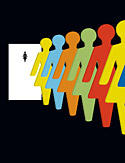
Illustration: Spacher
If it feels as if you plan your life around the proximity of the nearest bathroom, you're not alone.
An estimated one in six adults has overactive bladder (OAB). Common symptoms include a sudden, uncontrollable urge to go; needing to go more than eight times a day; waking up twice or more at night to urinate; and leakage (incontinence)."In the majority of cases, the cause is unknown," says Sandip Vasavada, MD, co-head of the female urology and voiding dysfunction section at the Cleveland Clinic. Incidence increases with age: For many women, OAB symptoms appear in their 40s. If a woman doesn't seek treatment, the condition can impact her quality of life, leading to depression and anxiety, fear of sexual intimacy, decreased work productivity, avoidance of travel, a greater risk of nighttime falls, and urinary tract infections, says Diane Kaschak Newman, codirector of the Penn Center for Continence and Pelvic Health at the University of Pennsylvania Medical Center.
The good news is that OAB can be brought under control with the following techniques Vasavada and Newman suggest.
Drink 6 to 8 Cups of Water a Day
Many women believe that drinking less water will ease their urgency. On the contrary, says Newman: Adequate fluid intake helps eliminate bladder irritants and can actually prevent the urgency or frequency of OAB. Drink throughout the day, and stop three to four hours before bedtime.
Do 30 Kegels Twice a Day
This simple move strengthens the pelvic muscles around the bladder. Best done after you've gone to the bathroom, Kegel exercises can be performed anytime, anywhere. To identify the right muscles, squeeze as if you're trying to stop the flow of urine (without tensing your thigh or stomach muscles). Once you know where to flex, tighten these muscles for 10 seconds, then release and relax for 10 seconds.
Eliminate Possible Irritants
One at a time, try reducing your intake of chocolate, cocoa, coffee (sadly, with OAB it can be a problem), tea, soda, alcohol, spicy foods, highly acidic foods (like citrus fruits and juices and tomato-based products), and anything containing aspartame-based sweeteners.
Keep a Diary for 3 Days
Track how frequently you empty your bladder to help your urologist diagnose your condition as well as identify symptoms and potential dietary irritants. Record what, how much, and when you eat and drink. Write down when you go. Note any incontinence episodes.
Consider Drug Therapy
If after all this you're still uncomfortable straying too far from the facilities, you may want to discuss medication with your doctor. Certain drugs can relax the muscle that triggers bladder contractions, and can reduce symptoms significantly within weeks.
Many women believe that drinking less water will ease their urgency. On the contrary, says Newman: Adequate fluid intake helps eliminate bladder irritants and can actually prevent the urgency or frequency of OAB. Drink throughout the day, and stop three to four hours before bedtime.
Do 30 Kegels Twice a Day
This simple move strengthens the pelvic muscles around the bladder. Best done after you've gone to the bathroom, Kegel exercises can be performed anytime, anywhere. To identify the right muscles, squeeze as if you're trying to stop the flow of urine (without tensing your thigh or stomach muscles). Once you know where to flex, tighten these muscles for 10 seconds, then release and relax for 10 seconds.
Eliminate Possible Irritants
One at a time, try reducing your intake of chocolate, cocoa, coffee (sadly, with OAB it can be a problem), tea, soda, alcohol, spicy foods, highly acidic foods (like citrus fruits and juices and tomato-based products), and anything containing aspartame-based sweeteners.
Keep a Diary for 3 Days
Track how frequently you empty your bladder to help your urologist diagnose your condition as well as identify symptoms and potential dietary irritants. Record what, how much, and when you eat and drink. Write down when you go. Note any incontinence episodes.
Consider Drug Therapy
If after all this you're still uncomfortable straying too far from the facilities, you may want to discuss medication with your doctor. Certain drugs can relax the muscle that triggers bladder contractions, and can reduce symptoms significantly within weeks.
As a reminder, always consult your doctor for medical advice and treatment before starting any program.




